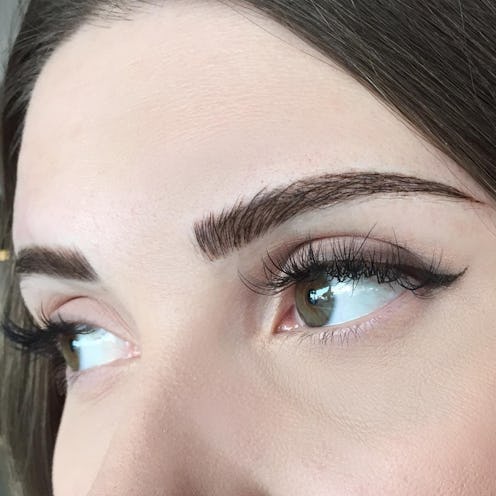
For anyone who got a litttttle too aggressive with the tweezers in their youth, or anyone who was born with barely-there-brows, there is a new trendy treatment that promises fuller, bolder brows: 3D Eyebrow Embroidery.
The treatment has been popular in the last decade in Malaysia and Singapore, and is just starting to catch on in the USA. It is also known as "cosmetic tattooing," "semi-permanent makeup," "pigment embroidery," "3-D eyebrow embroidery," or "microblading" (in case you want to do a thorough google search). The names, though, are kind of misleading — it's actually quite different than what you would normally associate with eyebrow makeup.
It is technically a form of tattooing, but the process involves implanting pigment beneath the surface of the skin with tiny disposable needles in a way makes it look like hair strokes. It's meant to give thin brows the appearance of natural thickness and volume.
I spoke to Shaughnessy Keely, who's one of the top microblading experts in the world, about what she thought people should know before going in for the treatment. After all, as Jack Black once said, "you must never underestimate the power of the eyebrow."
1. Pretty Much Anyone Can Do It
Any clients, men and women, who have suffered from hair loss such as Alopecia, chemotherapy, Trichotillomania (hair-pulling disorder) or just plain over-tweezing are all candidates for microblading. As a precaution, anyone taking accutane or any blood-thinning medications, or anyone who is pregnant or nursing, should not try microblading.
2. It Requires A Bit Of Preparation
Because the process is semi-permanent, it's important to know what you're getting into before you begin. Do your research, and be sure to choose an artist who's work you know you love and who you feel comfortable with. Keely suggests bringing in a few reference photos and some selfies of how you normally style your eyebrows to help with the designing process.
3. You'll Need To Get Your Skin Ready
In order to get the best results, the artist will need to work with your skin in as natural a state as possible. Avoid extreme sun exposure prior to your appointment as your artist will need to work with your skin in its most natural state. If you normally get your brows threaded, waxed, or tinted, please do so a minimum of 3 days before your appointment. Come to your appointment well-rested and hydrated and most importantly, not hungover!
4. It Makes Use Of Your Existing Eyebrows
A lot of people think they need to shave or remove their existing eyebrow hair before the treatment, but that's not the case. "Although this would absolutely be the case for a regular body tattoo, we keep and include as much of the natural brow hair as possible," says Keely. "We will only remove any hairs that fall outside of our final shape if necessary."
5. It Takes A Few Hours
The first step of the process, which Keely says is the most important, is deciding on a brow shape. Because it's semi-permanent, it's important to choose something you'll like and want to keep for a long time. Once the shape has been determined, the artist applies numbing cream to the area around the eyebrows and the microblading begins. The entire appointment, including all the prep work, is generally about 2-3 hours, but the actual microblading process is about 45 minutes to an hour, depending on the job.
6. It Doesn't Hurt
Before the microblading process begins, the artist will put numbing cream all over your eyebrows to minimize the pain. "Most of our customers compare it to threading or tweezing," says Keely. "Annoying but bearable!"
7. It Lasts A Long, Long Time
Because the process is done within the surface layers of your skin, it can last up to two years. Keely recommends annual appointments to keep things looking fresh and crisp.
8. There Are A Few Risks
As with any form of tattooing, there are certain risks associated with microblading. In order to keep yourself safe, be sure to follow pre- and post care instructions and follow proper hygiene when washing and touching your face. Also, make sure to choose a sterile salon where they only use single use, disposable needles and supplies. Allergic reactions and irritations to the treatment are incredibly rare, but they do happen in extreme circumstances, so Keely suggests speaking to a doctor before going in for the treatment.
Photos: Shaughnessy/Instagram